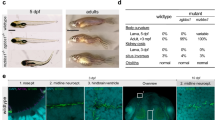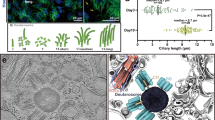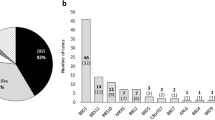Abstract
BBS4 is one of several proteins that cause Bardet-Biedl syndrome (BBS), a multisystemic disorder of genetic and clinical complexity. Here we show that BBS4 localizes to the centriolar satellites of centrosomes and basal bodies of primary cilia, where it functions as an adaptor of the p150glued subunit of the dynein transport machinery to recruit PCM1 (pericentriolar material 1 protein) and its associated cargo to the satellites. Silencing of BBS4 induces PCM1 mislocalization and concomitant deanchoring of centrosomal microtubules, arrest in cell division and apoptotic cell death. Expression of two truncated forms of BBS4 that are similar to those found in some individuals with BBS had a similar effect on PCM1 and microtubules. Our findings indicate that defective targeting or anchoring of pericentriolar proteins and microtubule disorganization contribute to the BBS phenotype and provide new insights into possible causes of familial obesity, diabetes and retinal degeneration.
This is a preview of subscription content, access via your institution
Access options
Subscribe to this journal
Receive 12 print issues and online access
$259.00 per year
only $21.58 per issue
Buy this article
- Purchase on SpringerLink
- Instant access to full article PDF
Prices may be subject to local taxes which are calculated during checkout








Similar content being viewed by others
References
Zimmerman, W., Sparks, C.A. & Doxsey, S.J. Amorphous no longer: the centrosome comes into focus. Curr. Opin. Cell Biol. 11, 122–128 (1999).
Zimmerman, W. & Doxsey, S.J. Construction of centrosomes and spindle poles by molecular motor-driven assembly of protein particles. Traffic 1, 927–934 (2000).
Ou, Y.Y., Zhang, M., Chi, S., Matyas, J.R. & Rattner, J.B. Higher order structure of the PCM adjacent to the centriole. Cell Motil. Cytoskeleton 55, 125–133 (2003).
Kubo, A., Sasaki, H., Yuba-Kubo, A., Tsukita, S. & Shiina, N. Centriolar satellites: Molecular characterization, ATP-dependent movement toward centrioles and possible involvement in ciliogenesis. J. Cell Biol. 147, 969–979 (1999).
Rattner, J.B. Ultrastructure of centrosome domains and identification of their protein components. in In The Centrosome (ed. Kalnins, V.I.) 45–69 (Academic, San Diego, 1992).
Bobinnec, Y. et al. Centriole disassembly in vivo and its effect on centrosome structure and function in vertebrate cells. J. Cell Biol. 143, 1575–1589 (1998).
Beisson, J. & Wright, M. Basal body/centriole assembly and continuity. Curr. Opin. Cell Biol. 15, 96–104 (2003).
Balczon, R., Bao, L. & Zimmer, W.E. PCM-1, A 228-kD centrosome autoantigen with a distinct cell cycle distribution. J. Cell Biol. 124, 783–793 (1994).
Dammermann, A. & Merdes, A. Assembly of centrosomal proteins and microtubule organization depends on PCM-1. J. Cell Biol. 159, 255–266 (2002).
Beales, P.L., Elcioglu, N., Woolf, A.S., Parker, D. & Flinter, F.A. New criteria for improved diagnosis of Bardet-Biedl syndrome: results of a population survey. J. Med. Genet. 36, 437–446 (1999).
Katsanis, N. et al. Triallelic inheritance in Bardet-Biedl syndrome, a mendelian recessive disorder. Science 293, 2256–2259 (2001).
Badano, J.L. et al. Identification of a novel Bardet-Biedl syndrome protein, BBS7, that shares structural features with BBS1 and BBS2. Am. J. Hum. Genet. 72, 650–658 (2003).
Mykytyn, K. et al. Identification of the gene (BBS1) most commonly involved in Bardet-Biedl syndrome, a complex human obesity syndrome. Nat. Genet. 31, 435–438 (2002).
Mykytyn, K. et al. Identification of the gene that, when mutated, causes the human obesity syndrome BBS4. Nat. Genet. 28, 188–191 (2001).
Nishimura, D.Y. et al. Positional cloning of a novel gene on chromosome 16q causing Bardet-Biedl syndrome (BBS2). Hum. Mol. Genet. 10, 865–874 (2001).
Katsanis, N. et al. Mutations in MKKS cause obesity, retinal dystrophy and renal malformations associated with Bardet-Biedl syndrome. Nat. Genet. 26, 67–70 (2000).
Slavotinek, A.M. et al. Mutations in MKKS cause Bardet-Biedl syndrome. Nat. Genet. 26, 15–16 (2000).
Ansley, S.J. et al. Basal body dysfunction is a likely cause of pleiotropic Bardet-Biedl syndrome. Nature 425, 628–633 (2003).
Rosenbaum, J.L. & Witman, G.B. Intraflagellar transport. Nat. Rev. Mol. Cell Biol. 3, 813–825 (2002).
Schultz, J., Copley, R.R., Doerks, T., Ponting, C.P. & Bork, P. SMART: a web-based tool for the study of genetically mobile domains. Nucleic Acids Res. 28, 231–234 (2000).
Blatch, G.L. & Lassle, M. The tetratricopeptide repeat: a structural motif mediating protein-protein interactions. Bioessays 21, 932–939 (1999).
Moudjou, M., Bordes, N., Paintrand, M. & Bornens, M. gamma-Tubulin in mammalian cells: the centrosomal and the cytosolic forms. J. Cell Sci. 109, 875–887 (1996).
Dictenberg, J.B. et al. Pericentrin and gamma-tubulin form a protein complex and are organized into a novel lattice at the centrosome. J. Cell Biol. 141, 163–174 (1998).
Vaughan, K.T. & Vallee, R.B. Cytoplasmic dynein binds dynactin through a direct interaction between the intermediate chains and p150Glued . J. Cell Biol. 131, 1507–1516 (1995).
Valle, R.D. The molecular motor toolbox for intracellular transport. Cell 112, 467–480 (2003).
Waterman-Storer, C.M., Karki, S. & Holzhbaur, E.L. The p150Glued component of the dynactin complex binds to both microtubules and the actin-related protein centractin (Arp-1). Proc. Natl. Acad. Sci. USA 92, 1634–1638 (1995).
Balczon, R., Varden, C.E. & Schroer, T.A. Role for microtubules in centrosome doubling in Chinese hamster ovary cells. Cell Motil. Cytoskeleton 42, 60–72 (1999).
Young, A., Dictenberg, J.B., Purohit, A., Tuft, R. & Doxsey, S.J. Cytoplasmic dynein-mediated assembly of pericentrin and gamma tubulin onto centrosomes. Mol. Biol. Cell 11, 2047–2056 (2000).
Brummelkamp, T.R., Bernards, R., Agami, R. A system for stable expression of short interfering RNAs in mammalian cells. Science 296, 550–553 (2002).
Acknowledgements
We thank C. Beh and S. Huston for their critical evaluation of this manuscript and P. Scambler for discussions. This study was supported in part by a National Institute of Child Health and Development, National Institutes of Health grant and the March of Dimes (N.K.); National Cancer Institute of Canada (Terry Fox Run) and Heart and Stroke Foundation of BC and Yukon (M.R.L.); the National Kidney Research Fund (B.E.H.); and the Birth Defects Foundation and the Wellcome Trust (P.L.B.). P.L.B. is a Wellcome Trust Senior Research Fellow. J.C.K. and M.A.E. hold scholarships from the Michael Smith Foundation for Health Research and Heart and Stroke Foundation of Canada, respectively, and M.R.L. is the recipient of scholar awards from the Canadian Institutes of Health Research and Michael Smith Foundation for Health Research.
Author information
Authors and Affiliations
Corresponding authors
Ethics declarations
Competing interests
The authors declare no competing financial interests.
Supplementary information
Rights and permissions
About this article
Cite this article
Kim, J., Badano, J., Sibold, S. et al. The Bardet-Biedl protein BBS4 targets cargo to the pericentriolar region and is required for microtubule anchoring and cell cycle progression. Nat Genet 36, 462–470 (2004). https://doi.org/10.1038/ng1352
Received:
Accepted:
Published:
Issue date:
DOI: https://doi.org/10.1038/ng1352
This article is cited by
-
CCHCR1-astrin interaction promotes centriole duplication through recruitment of CEP72
BMC Biology (2022)
-
BBS4 protein has basal body/ciliary localization in sensory organs but extra-ciliary localization in oligodendrocytes during human development
Cell and Tissue Research (2021)
-
Bardet–Biedl syndrome and related disorders in Japan
Journal of Human Genetics (2020)
-
Kinesin 1 regulates cilia length through an interaction with the Bardet-Biedl syndrome related protein CCDC28B
Scientific Reports (2018)
-
Functions and dysfunctions of the mammalian centrosome in health, disorders, disease, and aging
Histochemistry and Cell Biology (2018)



